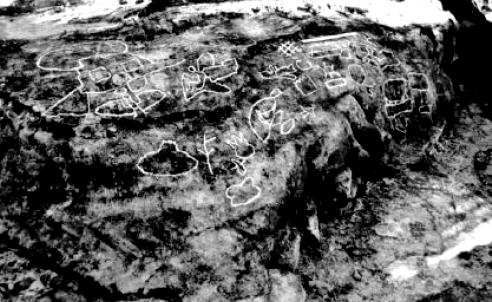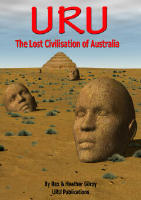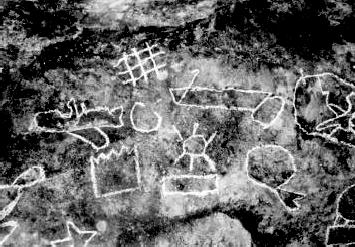Lost Science Of The Uru [continued]
Yet this parched landscape has not experienced regular rainfalls since the Ice-Age pasturelands hereabouts dried up at least 30,000 years ago!
In the Adelaide Hills, South Australia, the fossilised sandalled foot impressions of an adult and child were discovered in a mudstone shoal many years ago. The impressions suggested well-made leather sandals unknown to the primitive Aborigines. These fossils were dated at least 10,000 years old.
Many other ancient rock engravings of non-Aboriginal origin can be found at widely-scattered inland locations throughout Australia, depicting human figures, both male and female, clothed in apparent well-made garments; coats, trousers, long sleeved robe-like garments with buttons, clasps and belts, head dresses and boots, many dating back anywhere between 30,000 to 50,000 years.
And at a Hunter Valley location deep inland from Newcastle, NSW there stand three huge menhirs [standing stones] 7.6m above the ground, extending below surface for about 18.3m! Each of these massive stones are placed close together on an east-west axis and are alien to the area. One is of ironstone, the second is granite and the third a type of slate. They are flattish, weighing 2 tons to a cubic yard! Researchers have found that the stones, which are in alignment with a lengthy row of monoliths erected nearby, act as a kind of stone-age electrical battery, storing and releasing an often strong current of natural earth electricity which flows back and forth along the nearby alignment.
Great numbers of workers would have been needed to drag and erect the 26m length monoliths [working to a pre-arranged plan], which they had removed from great distances from the site; a mammoth task thought to have been carried out over 20,000 years ago. Also, at Fugal on the coast of the NSW side of the Queensland border, a buried stone ‘wall’ constructed of massive blocks was uncovered by locals many years ago below ground near the shoreline, and which skin divers later found continued on submerged far out beneath the ocean for some distance. The ‘wall’ is said to be about 21.3m wide and about 18.3m high. The massive structure, say skindivers, resembles and ancient stone wharf.
The stones fit so close together that a knife blade cannot be inserted between them. What do the foregoing discoveries tell us? They demonstrate that, by 30,000 and 20,000 years ago, a highly advanced Stone-Age “super-civilisation” ruled Australia. In each case local Aborigines describe them as traces of a mysterious race of pale-skinned [ie white] “culture-heroes” [gods] who ruled the continent in the long-ago ‘Dreamtime’. And at one Uru rock inscription site near Katoomba NSW, the author discovered a number of ancient glyphs inscribed upon a strata of red slate at the base of a sandstone-ironstone slope near a cliff edge.
However, what really interested me was that this 8cm thick slate rock, having broken away on the edge, had exposed other, far more ancient glyphs, cut into the sandstone shoal beneath, and which appeared to continue on under the overlaying red slate. The script engraved upon the slate rock is at least several thousand years old; but how old is the inscription beneath?
Australia is a land of unsurpassed mysteries of ancient human history, [and it is certain], of the very beginnings of world civilistation in the form of the mighty Uru. Although a Stone-Age people they had received a ‘kick start’, triggered off it seems certain, by a fascination with the movements of the heavenly bodies, which struck the divine spark that illuminated mankind.
It led them to develop an astronomical science which aided their agricultural endeavours as well as maritime navigation; yet it was only one aspect of their advanced stone-age scientific achievements, and that is what this chapter is concerned with. Of course, due to the lack of
written records made upon perishable
materials, we must rely solely upon
what information we can deduce from
their rock inscriptions, for the scant
information so far gathered on this
remarkable people.
The first aspect of their
scientific attainments which strikes us
are their megalithic stone arrangements, employed not only in
the observations of the risings and
settings of the stars and planets, but
also in the plotting of the risings and
settings of the Sun on the Summer and
Winter Solstices [22nd December and
22nd June respectively in Australia]. By
their observations they discovered the
sphericity of the earth at an early
period in their megalithic activities. Yet
the methods by which they moved
these stones, sometimes weighing
hundreds of tonnes, continues to elude
us. Wooden rollers?
Perhaps for
smaller stones, but how were they able
to move and erect monolithic 26m
long slabs or as described in Chapter
Seven a flat granite slab over 4m tall by
24m long and 118m circumference
[upon which a huge phallic-shaped
tomb was erected]?
Their accurate arrangement of
the stone alignments reveals a
mathematical knowledge which has yet
to be fully understood, as were their
units of measurement, particularly
concerning alignments extending over
long distances. A small stone slab
recently unearthed at a Katoomba
NSW astronomical site bears small fine
engraved lines marking out degrees.
The Uruan megalithic
astronomer-builders certainly worked
from surveyed plans written upon
perishable materials, such as animal
hide, or even a papyrus-type paper
similar to that of the later Egyptians.
They certainly surveyed sites
prior to the erection of temples, tombs
and other structures, as demonstrated
by many accurately placed stones
forming megalithic monuments across
Australia. This is also to be seen in the “serpent paths”, or Ley Lines that the
Uru established, and which extend
across country for perhaps hundreds
of kilometres, and which follow both
man-made sites, ancient tracks, hill and
mountain peaks.
While Uruan ‘Birdpeople’ were
strapping crude hang gliders to their
backs and leaping from clifftops,
other, more foreward thinking men
were apparently creating an even more
advanced aeronautical technology…
Weathered rock engravings
near Katoomba, found by the author
in June 2003, in the vicinity of “Birdman” images, describe craft
which appear to be more than one
type of ancient hot-air balloon, as well
as apparent gliders and other mystery
objects. If these petroglyphs,
thousands of years old, are what they
appear to be, adventurous Uruans in mighty airships once cruised Australian
skies.
It does not seem impossible
that Uruan thinkers, watching burnt
leaves etc rising with the heat from a
fire, could have come by the idea of
trapping that hot air, perhaps at first in
an experimental light-weight
receptacle, such as perhaps a small bag
made of papyrus-type paper, then later
in a far larger, passenger-carrying
balloon-type craft.
However, a passenger-carrying
balloon is a far cry from a small paper
bag, and would have required a great
deal of planning and experimentation
before the first test flight could have
been attempted.
Perhaps thinly tanned animal
hide was sewn together with twine and
sealed with tree gum before being
stretched over a framework of
lightweight saplings, with an opening
wide enough to allow the hot air from
a fire in a gondola beneath to enter the
balloon. A small opening on the top of
the balloon opened and closed by a
flap worked by a cord from the
gondola would have been necessary to
avoid condensation from forming
inside the balloon. The gondola would
have had to have been made of
lightweight interlaced saplings and a
stone fireplace located beneath, with a
wood supply kept burning to provide a
continuous flow of hot air into the
hole above to keep the balloon
airborne.
A crew of at least two men
would have been needed, and to
overcome the unavoidable weight of
the balloon material, fireplace, wood
supply and its crew, a balloon of
considerable size would have been
necessary.
It is likely that until the balloon
was sufficiently filled with hot air while
on the ground, stakes were positioned
to keep it from collapsing. At the end
of a flight, in order to descend the
crew could have kept the top flap open
long enough to allow sufficient air to escape to allow a slow descent.
Eventually, through trial and error a
long, wide animal hide funnel could
have been added to the hole beneath,
which could be clamped shut after
enough hot air had entered the
balloon.
From a study of ancient rock
art just mentioned it appears that the
Uru gradually advanced this
technology, with massive craft
containing crews of from three to four
individuals.
The designs of apparent
balloon craft described in the ancient
petroglyphs include airships with builtin
gondolas a door and windows,
steered by a rudder and flaps.
Other
balloon craft are “flying saucer” in
shape, and one particular petroglyph
shows a downview of the circular craft
with interior compartments. Beneath
this image is another huge balloon
model showing two human figures
inside, a fireplace, outer flaps and large
flap-like rudder at the end of the craft.
Above a “flying saucer” type balloon a
human figure is depicted, attached to a
bag-like object. Did the Uru also
invent a small balloon to lift an
individual off the ground for purposes
unknown?
Other images in the Katoomba“balloon art” site show individuals
apparently steering flying craft, one of
these is “saucer shaped”, the other
more balloon-like with a large ‘tail’ at
the rear end, the ‘pilot’ being seated
while he works controls.
From a study of the engravings
of these balloon craft displaying their
side flaps and large rear rudder, I
theorise the following:
Like the rudder, the side flaps
were large, each worked by an
individual who turned the rudder from
one side to the other, while the flaps
were moved up or down [depending
upon which direction the craft was to
move], all of which were attached to
long poles resting upon upright stakes
with windlass handles at the end.

This extensive series of badly worn, ancient Uruan rock engravings found
outside Katoomba NSW [chalked in due to their faintness for photographic purposes]
describe apparent Birdmen, men in aeroplane-like gliders, saucer-shaped and other
balloon -type flying craft. There is an inscription explaining how to cons truct these craft
interspersed among flying craft images:
Photo copyright © Rex Gilroy 2004.
A fourth individual kept the fire going
and worked the condensation flap
cord.
The Katoomba petroglyphs are
interspersed among glyphs forming the
message:
“The wings of the Birdmen of the Sun, made with saplings and animal hides
sealed with tree gum, as are the flying
vessels that glide.
With the sun’s heat
ships fly like the birds, watched by
Nim’s Eye. With enclosed fire, in ships
of wicker men rise, with the hot breath
of the Sun, ships of saplings and air fly.
They fly for Nim”.
These engravings, over 15,000
years old, suggest the Uru were the
first people to conquer the air. Yet
how did they come by this advanced
Stone Age technology, especially their“flying saucer” shaped balloon
airships. Some may argue that this
super race of the Australian Ice Age
might have been influenced by extraterrestrial
visitors; yet it is just as likely
that the Uruan conquest of the air was
a natural consequence of advances in
their by then highly advanced stoneage
science.
In Chapter Eleven we have
seen that hang gliders were used by the
men and women of the Birdman Cult
in ceremonial flights in honour of I-na
the Eagle or Bird of the Sun. Flights
were also enjoyed as a leisure pastime.
In the development of these first hang
gliders, Uruan thinkers would have
made observations of birds in flight
and studied their physical structure,
which would have not only aided them
in the development of the hang glider,
but also in that of the aircraft-like
gliders depicted in the Katoomba rock
engravings.
The invention of flying craft
was THE great Uruan scientific
achievement, for their development
went far beyond ceremonial and
recreational use, for it led to better communications between far-flung
communities and kingdoms. Now
trade goods could be flown rather than
carried overland or sailed along river
systems, and the length of flights over
the land were only limited by the
amount of wood on board, requiring
occasional landings to gather more
fuel.
There can be no doubt that
many experimental hang glider flights
came to grief, and in the case of
balloon flights particularly so, for
without great care at all times these
would have become fire traps.
Balloon flights across
Australian skies were one thing, but
exploration over vast distances of
ocean to other lands would have been
greatly handicapped by the constant
need for wood fuel; yet perhaps the
Uru were able to overcome their
problem with gigantic craft capable of
carrying enough wood.
Who can say
what they may have accomplished in
these matters. Island-hopping was not
impossible, as balloon flights could
have reached Tasmania, the Torres
Strait Islands and New Guinea; from
where flights could have carried these
Uruan airmen into Island Melanesia,
even perhaps as far as New Zealand
and other islands in the Pacific, or
northwards through South East Asia’s
island chains.
The sight of these huge
airships descending from the sky
would have remained long in the race
memories of the islanders, and might
explain many [but not all] traditions of‘Gods’ who once descended ‘from the
heavens’ imparting culture and
civilisation to their ancestors.
From this 30m high clifftop men and
women of the Uruan Birdman Cult, once
leapt to soar, in honour of I-na, the
Eagle of the Sun, who in Uruan religious
mythology carried the Sun-God Nim,
across the heavens each day.
Photo copyright © Rex Gilroy 2004.

 Glider Craft?
Glider Craft? 


 Ballon & Birdman Image
Ballon & Birdman Image  Birdman Sketch
Birdman Sketch  Human Figures
Human Figures 

